2021 Science Highlights
The Most Distant Quasar and its Host Galaxy
Distant quasars are unique tracers to study the formation of the earliest supermassive black holes (SMBHs) and the history of cosmic reionization. Despite extensive efforts, only two quasars have been found at z ≥ 7.5, due to a combination of their low spatial density and the high contamination rate in quasar selection. Wang et al. report the discovery of a luminous quasar at z = 7.642, J0313-1806, the most distant quasar yet known. This quasar has a bolometric luminosity of 3.6 × 1013L⊙. Deep spectroscopic observations reveal a SMBH with a mass of (1.6 ± 0.4) × 109 M⊙ in this quasar. The existence of such a massive SMBH just ∼670 million years after the Big Bang challenges significantly theoretical models of SMBH growth. In addition, the quasar spectrum exhibits strong broad absorption line (BAL) features in C IV and Si IV, with a maximum velocity close to 20% of the speed of light. The relativistic BAL features, combined with a strongly blueshifted C IV emission line, indicate that there is a strong active galactic nucleus (AGN)-driven outflow in this system. Atacama Large Millimeter/submillimeter Array (ALMA) observations detect the dust continuum and [C II] emission from the quasar host galaxy, yielding an accurate redshift of 7.6423 ± 0.0013 and suggesting that the quasar is hosted by an intensely star-forming galaxy, with a star formation rate of ∼200 M⊙ yr-1 and a dust mass of ∼7 × 107 M⊙. These observations present the most extreme example of coeval formation of a black hole and galaxy in the very early Universe. Follow-up observations of this reionization-era BAL quasar will provide a powerful probe of the effects of AGN feedback on the growth of the earliest massive galaxies.
Figure caption: ALMA observations of the dust continuum and [C II] line. [Left] The dust continuum map with contour levels of [3, 5, 7, 9, 11, 13] × 0.02 mJy. [Middle] The integrated [C ii] emission with contour levels of [3, 4] × 0.04 Jy km s−1. The sizes of the continuum cutout and the [C II] cutout are 4'' × 4''. The white crosses in the left and middle panels highlight the quasar position derived from VISTA Hemisphere Survey infrared images. [Right] The [C II] spectrum (black) and noise vector (blue) extracted from the data cube with an aperture diameter of 15 centered at the peak position of the continuum map. The spectral fitting (red line) gives FWHM = 312 ± 94 km s−1 and z[CII] = 7.6423 ± 0.0013.
Publication: Feige Wang (University of Arizona) et al., A Luminous Quasar at Redshift 7.642, Astrophysical Journal Letters 907, L1 (20 January 2021).
NRAO Press Release: Quasar Discovery Sets New Distance Record
The Most Distant Radio Loud Quasar
 Powerful radio jets from supermassive black holes (SMBHs) have a profound influence on their local environments, regulating star formation in the host galaxy and polluting the intergalactic medium with atoms and magnetic fields. They may also facilitate the formation of SMBH by removing angular momentum from the accretion disk. However, finding radio Active Galactic Nuclei in the early Universe has proven difficult.
Powerful radio jets from supermassive black holes (SMBHs) have a profound influence on their local environments, regulating star formation in the host galaxy and polluting the intergalactic medium with atoms and magnetic fields. They may also facilitate the formation of SMBH by removing angular momentum from the accretion disk. However, finding radio Active Galactic Nuclei in the early Universe has proven difficult.
Radio sources at the highest redshifts provide unique information on the first massive galaxies and black holes, the densest primordial environments, and the epoch of reionization. The number of astronomical objects identified at z > 6 has increased dramatically over the last few years, but previously only three radio-loud sources have been reported at z >6 , the most distant being a quasar at z = 6.18.
These two contributions–from the Jansky Very Large Array (VLA: Bañados et al.) and the Very Long Baseline Array (VLBA: Momjiam et al.)–report the discovery and characterization of the most distant radio-loud Active Galactic Nucleus to date, at z = 6.82, or just ~800 Myr after the Big Bang. This source has a black hole mass of ~ 3 x 108 M⊙ and is one of the fastest accreting quasars. The VLBA imaging implies a marginally resolved source, with a size ≤ 10 milli-arcseconds, or ~ 50 parsecs. The small size, but steep radio spectrum at high frequency, implies a very young radio jet, with an estimated age of only ~ 2000 years.
Figure caption: [Left] VLBA 1.4 GHz image of the z = 6.8 radio loud quasar. [Right] A compilation of all the z > 5 radio loud AGN known (Banados et al. 2021; Momjian et al. 2021).
Publication-1: Eduardo Bañados (Max Planck Institute for Astronomy, Carnegie Institution of Washington) et al., The Discovery of a Highly Accreting, Radio-loud Quasar at z=6.82, Astrophysical Journal 909, 80 (1 March 2021).
Publication-2: Emmanuel Momjiam (NRAO) et al., Resolving the Radio Emission from the Quasar P172+18 at z = 6.82, Astronomical Journal, 161, 207 (1 May 2021).
NRAO Press Release: Most Distant Cosmic Jet Providing Clues About Early Universe
The Most Distant Blazar
 The authors present Director's Discretionary Time multi-frequency observations obtained with the Jansky Very Large Array (VLA) and the Very Long Baseline Array (VLBA) of the blazar PSO J030947.49+271757.31 (hereafter PSO J0309+27) at z = 6.10 ± 0.03. The milli- arcsecond angular resolution of the VLBA observations at 1.5, 5 and 8.4 GHz unveils a bright one-sided jet extended for ∼ 500 parsecs in projection. This high-z radio-loud Active Galactic Nucleus is resolved into multiple compact sub-components, embedded in a more diffuse and faint radio emission, which enshrouds them in a continuous jet structure. The authors derive limits on some physical parameters directly from the observable quantities, such as viewing angle, Lorentz and Doppler factors. If PSO J0309+27 is a genuine blazar, as suggested by its X-ray properties, then its bulk Lorentz factor must be relatively low (less than 5). Such values would favor a scenario currently proposed to reconcile the paucity of high-z blazars with respect to current predictions. Nevertheless, the authors cannot exclude that PSO J0309+27 is seen under a larger viewing angle, which would imply that the X-ray emission must be enhanced, e.g., by inverse Compton with the Cosmic Microwave Background. More stringent constraints on the bulk Lorentz factor in PSO J0309+27 and the other high-z blazars are necessary to test whether their properties are intrinsically different with respect to the low-z blazar population.
The authors present Director's Discretionary Time multi-frequency observations obtained with the Jansky Very Large Array (VLA) and the Very Long Baseline Array (VLBA) of the blazar PSO J030947.49+271757.31 (hereafter PSO J0309+27) at z = 6.10 ± 0.03. The milli- arcsecond angular resolution of the VLBA observations at 1.5, 5 and 8.4 GHz unveils a bright one-sided jet extended for ∼ 500 parsecs in projection. This high-z radio-loud Active Galactic Nucleus is resolved into multiple compact sub-components, embedded in a more diffuse and faint radio emission, which enshrouds them in a continuous jet structure. The authors derive limits on some physical parameters directly from the observable quantities, such as viewing angle, Lorentz and Doppler factors. If PSO J0309+27 is a genuine blazar, as suggested by its X-ray properties, then its bulk Lorentz factor must be relatively low (less than 5). Such values would favor a scenario currently proposed to reconcile the paucity of high-z blazars with respect to current predictions. Nevertheless, the authors cannot exclude that PSO J0309+27 is seen under a larger viewing angle, which would imply that the X-ray emission must be enhanced, e.g., by inverse Compton with the Cosmic Microwave Background. More stringent constraints on the bulk Lorentz factor in PSO J0309+27 and the other high-z blazars are necessary to test whether their properties are intrinsically different with respect to the low-z blazar population.
Image Caption: [Left to Right ] VLBA images of the z=6.1 blazar at 1.5 GHz, 5 GHz, and 8.4 GHz, down to 2 milli-arcsecond resolution
Publication: Cristiana Spingola (Bologna, INAF) et al. Parsec-scale Properties of the Radio Brightest Jetted AGN at z > 6, Astronomy & Astrophysics, 643, L12 (November 2020).
Unexpected Radio Structures
 The authors present new deep, high-resolution, 1.5 GHz observations of the prototypical nearby Perseus galaxy cluster from the Karl G. Jansky Very Large Array. They isolate for the first time the complete tail of radio emission of the bent-jet radio galaxy NGC 1272, which had been previously mistaken to be part of the radio mini-halo. The possibility that diffuse radio galaxy emission contributes to mini-halo emission may be a general phenomenon in relaxed cool-core clusters, and should be explored. The collimated jets of NGC 1272 initially bend to the west, and then transition eastward into faint, 60 kpc extensions with eddy-like structures and filaments. The authors suggest interpretations for these structures that involve bulk motions of intracluster gas, the galaxy's orbit in the cluster including projection effects, and the passage of the galaxy through a sloshing cold front. Instabilities and turbulence created at the surface of this cold front and in the turbulent wake of the infalling host galaxy most likely play a role in the formation of the observed structures. The authors also discover a series of faint rings, south-east of NGC 1272, a type of structure that has never been seen in galaxy clusters.
The authors present new deep, high-resolution, 1.5 GHz observations of the prototypical nearby Perseus galaxy cluster from the Karl G. Jansky Very Large Array. They isolate for the first time the complete tail of radio emission of the bent-jet radio galaxy NGC 1272, which had been previously mistaken to be part of the radio mini-halo. The possibility that diffuse radio galaxy emission contributes to mini-halo emission may be a general phenomenon in relaxed cool-core clusters, and should be explored. The collimated jets of NGC 1272 initially bend to the west, and then transition eastward into faint, 60 kpc extensions with eddy-like structures and filaments. The authors suggest interpretations for these structures that involve bulk motions of intracluster gas, the galaxy's orbit in the cluster including projection effects, and the passage of the galaxy through a sloshing cold front. Instabilities and turbulence created at the surface of this cold front and in the turbulent wake of the infalling host galaxy most likely play a role in the formation of the observed structures. The authors also discover a series of faint rings, south-east of NGC 1272, a type of structure that has never been seen in galaxy clusters.
Figure Caption: Sloan Digital Sky Survey mosaic with VLA images of radio jets in the Perseus cluster, showing the strong interaction of the jets with the cluster gas on 100 kpc scales.
Publication: Marie–Lou Gendoon–Marsolais et al. VLA Resolves Unexpected Radio Structures in the Perseus Cluster of Galaxies, Astrophysical Journal, 911, L56 (April 2021).
NRAO Press Release: IMAGE RELEASE: Galaxies in the Perseus Cluster
Probing the Depths of Neptune
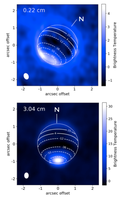 The authors present spatially resolved (0.1-1.0 arcsec) radio maps of Neptune acquired with the Jansky Very Large Array and the Atacama Large Millimeter/submillimeter Array between 2015 and 2017. Combined, these observations probe from just below the main methane cloud deck at ∼1 bar down to the NH4SH cloud at ∼50 bar. Prominent latitudinal variations in the brightness temperature are seen across the disk. Depending on wavelength, the south polar region is 5 K to 40 K brighter than the mid-latitudes and northern equatorial region. The authors use radiative transfer modeling coupled to Markov Chain Monte Carlo methods to retrieve H2S, NH3, and CH4 abundance profiles across the disk, though only strong constraints can be made for H2S.
The authors present spatially resolved (0.1-1.0 arcsec) radio maps of Neptune acquired with the Jansky Very Large Array and the Atacama Large Millimeter/submillimeter Array between 2015 and 2017. Combined, these observations probe from just below the main methane cloud deck at ∼1 bar down to the NH4SH cloud at ∼50 bar. Prominent latitudinal variations in the brightness temperature are seen across the disk. Depending on wavelength, the south polar region is 5 K to 40 K brighter than the mid-latitudes and northern equatorial region. The authors use radiative transfer modeling coupled to Markov Chain Monte Carlo methods to retrieve H2S, NH3, and CH4 abundance profiles across the disk, though only strong constraints can be made for H2S.
Below all cloud formation, the data are well fit by 53.8+18.9−13.4 x and 3.9+2.1−3.1 x protosolar enrichment in the H2S and NH3 abundances, respectively, assuming a dry adiabat. Models in which the radio-cold mid-latitudes and northern equatorial region are supersaturated in H2S are statistically favored over models following strict thermochemical equilibrium. H2S is more abundant at the equatorial region than at the poles, indicative of strong, persistent global circulation. These results imply that Neptune's sulfur-to-nitrogen ratio exceeds unity, as H2S is more abundant than NH3 in every retrieval. The absence of NH3 above 50 bar can be explained either by partial dissolution of NH3 in an ionic ocean at GPa pressures or by a planet formation scenario in which hydrated clathrates preferentially delivered sulfur rather than nitrogen onto planetesimals, or a combination of these hypotheses.
Image Caption: Examples of VLA and ALMA images of Neptune.
Publication: Joshua Tollefson (University of California, Berkeley) et al., Neptune's Spatial Brightness Temperature Variations from the VLA and ALMA, 2021, The Planetary Science Journal, 2, Issue 3, L105.
The Brightest Flare from Proxima Centauri
 M-dwarfs are the most common stars, and the most likely to host planets that could harbor life. The M-dwarf Proxima Centauri is at the center of the habitability discussion. It is the nearest exoplanetary system (1.3 parsecs) and has a likely Earth-mass planet with T ~ 230 K at 0.05 AU.
M-dwarfs are the most common stars, and the most likely to host planets that could harbor life. The M-dwarf Proxima Centauri is at the center of the habitability discussion. It is the nearest exoplanetary system (1.3 parsecs) and has a likely Earth-mass planet with T ~ 230 K at 0.05 AU.
MacGregor et al. present here the discovery of an extreme flaring event from Proxima Centauri by the Australian Square Kilometre Array Pathfinder (ASKAP), Atacama Large Millimeter/submillimeter Array (ALMA), Hubble Space Telescope (HST), Transiting Exoplanet Survey Satellite (TESS), and the du Pont Telescope that occurred on 1 May 2019. In the millimeter and far ultraviolet (FUV), this flare is the brightest ever detected, brightening by a factor of >1000 and >14,000 as seen by ALMA and HST, respectively. The millimeter and FUV continuum emission trace each other closely during the flare, suggesting that millimeter emission could serve as a proxy for FUV emission from stellar flares and become a powerful new tool to constrain the high-energy radiation environment of exoplanets. Surprisingly, optical emission associated with the event peaks at a much lower level with a time delay. The initial burst has an extremely short duration, lasting less than 10 seconds. Taken together with the growing sample of millimeter M dwarf flares, this event suggests that millimeter emission is actually common during stellar flares and often originates from short burst-like events.
Extreme flares are driven by magnetic reconnection in the stellar atmosphere, and indicate a highly magnetically active star. The heightened magnetic activity of M-dwarfs could be detrimental to the life formation process.
Image Caption: VLA 1.3cm and HST UV light curves of the extreme flare from Proxima Centauri.
Publication: Meredith A. MacGregor (University of Colorado) et al., Discovery of an Extremely Short Duration Flare from Proxima Centauri Using Millimeter through Far-ultraviolet Observations, 2021, Astrophysical Journal Letters, 911, Issue 2, L25 (20 April 2021).
NRAO Press Release: Record-breaking Stellar Flare From Nearby Star Recorded in Multiple Wavelengths for the First Time
Early Massive Star Formation
De Pree et al. present new Jansky Very Large Array (VLA) images of the central region of the W49A star-forming region at 3.6 cm and at 7 mm at resolutions of 0.15 arcsec (1650 AU) and 0.04 arcsec (440 AU), respectively. The 3.6 cm data reveal new morphological detail in the ultracompact H II region population, as well as several previously unknown and unresolved sources. In particular, source A shows elongated, edge-brightened bipolar lobes, indicative of a collimated outflow, and source E is resolved into three spherical components.
The authors also present VLA observations of radio recombination lines at 3.6 cm and 7 mm, and IRAM Northern Extended Millimeter Array (NOEMA) observations at 1.2 mm. Three of the smallest ultracompact H II regions (sources A, B2, and G2) all show broad kinematic linewidths, with ΔVFWHM ≳ 40 km s-1. A multi-line analysis indicates that broad linewidths remain after correcting for pressure broadening effects, suggesting the presence of supersonic flows. Substantial changes in linewidth over the 21 yr time baseline at both 3.6 cm and 7 mm are found for source G2. At 3.6 cm, the linewidth of G2 changed from 31.7 ± 1.8 km s-1 to 55.6 ± 2.7 km s-1, an increase of +23.9 ± 3.4 km s-1. The G2 source was previously reported to have shown a 3.6 cm continuum flux density decrease of 40% between 1994 and 2015. This source sits near the center of a very young bipolar outflow whose variability may have produced these changes.
Image Caption: VLA 3.6cm image at 0.15 arcsec resolution of W49A
Publication: C. G. De Pree (Agnes Scott College) et al., Time-variable Radio Recombination Line Emission in W49A, Astronomical Journal, 160, 234 (November 2020).
NRAO Press Release: IMAGE RELEASE: New Look at Bright Stellar Nursery
Polarimetric Imaging of M87
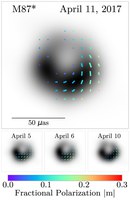 The Event Horizon Telescope (EHT), featuring the Atacama Large Millimeter/submillimeter Array (ALMA) as its anchor element, has presented their polarimetric imaging at 240 GHz around the supermassive black hole in M87 on event-horizon scales. This polarized synchrotron radiation probes the structure of magnetic fields and the plasma properties near the black hole. The field geometry appears as a spiral. The fractional polarization is low (<20%), indicating high Faraday rotation, from which the research team estimates ne ∼ 104-7 cm-3, B ∼ 1-30 G, and Te ∼ (1-12) × 1010 K, in the radiating plasma.
The Event Horizon Telescope (EHT), featuring the Atacama Large Millimeter/submillimeter Array (ALMA) as its anchor element, has presented their polarimetric imaging at 240 GHz around the supermassive black hole in M87 on event-horizon scales. This polarized synchrotron radiation probes the structure of magnetic fields and the plasma properties near the black hole. The field geometry appears as a spiral. The fractional polarization is low (<20%), indicating high Faraday rotation, from which the research team estimates ne ∼ 104-7 cm-3, B ∼ 1-30 G, and Te ∼ (1-12) × 1010 K, in the radiating plasma.
The collaboration shows that the net azimuthal linear polarization pattern may result from organized, poloidal magnetic fields in the emission region. In a quantitative comparison with a large library of simulated polarimetric images from general relativistic magnetohydrodynamic (GRMHD) simulations, the authors identify a subset of physical models that can explain critical features of the polarimetric EHT observations while producing a relativistic jet of sufficient power. The consistent GRMHD models are all of magnetically arrested accretion disks, where near-horizon magnetic fields are dynamically important. Models enable the team to infer a mass accretion rate onto the black hole in M87 of (3-20) × 10-4 M⊙ yr-1. Strong fields may also be key to the physics of relativistic jet launch.
Image Caption: EHT 240 GHz images of total intensity, and fractional polarization and position angle in M87.
Publication: Event Horizon Telescope Collaboration, First M87 Event Horizon Telescope Results. VIII. Magnetic Field Structure near The Event Horizon, Astrophysical Journal Letters, 910, L13 (March 2021).
NRAO Press Release: New Image Reveal Magnetic Structures Near Supermassive Black Hole
Multi-wavelength Properties of M87
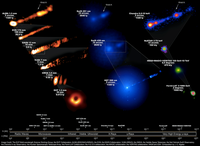 The Event Horizon Telescope (EHT) Collaboration succeeded in capturing the first direct image of the center of the M87 galaxy. The asymmetric ring morphology and size are consistent with theoretical expectations for a weakly accreting supermassive black hole of mass ∼6.5 × 109M⊙. The Collaboration partnered with several international ground- and space-based facilities for an extensive, quasi-simultaneous multi-wavelength campaign. This Letter presents the results and analysis of this campaign, as well as the multi-wavelength data as a legacy data repository. The EHT Collaboration captured M87 in a historically low state, and the core flux dominates over HST-1 at high energies, making it possible to combine core flux constraints with the more spatially precise very long baseline interferometry data. The authors present the most complete simultaneous multi-wavelength spectrum of the active nucleus to date, and discuss the complexity and caveats of combining data from different spatial scales into one broadband spectrum. The Very Long Baseline Array and the Atacama Large Millimeter/submillimeter Array played key roles in this multi-wavelength campaign.
The Event Horizon Telescope (EHT) Collaboration succeeded in capturing the first direct image of the center of the M87 galaxy. The asymmetric ring morphology and size are consistent with theoretical expectations for a weakly accreting supermassive black hole of mass ∼6.5 × 109M⊙. The Collaboration partnered with several international ground- and space-based facilities for an extensive, quasi-simultaneous multi-wavelength campaign. This Letter presents the results and analysis of this campaign, as well as the multi-wavelength data as a legacy data repository. The EHT Collaboration captured M87 in a historically low state, and the core flux dominates over HST-1 at high energies, making it possible to combine core flux constraints with the more spatially precise very long baseline interferometry data. The authors present the most complete simultaneous multi-wavelength spectrum of the active nucleus to date, and discuss the complexity and caveats of combining data from different spatial scales into one broadband spectrum. The Very Long Baseline Array and the Atacama Large Millimeter/submillimeter Array played key roles in this multi-wavelength campaign.
The Collaboration applied two heuristic, isotropic leptonic single-zone models to provide insight into the basic source properties, but concluded that a structured jet is necessary to explain the M87 spectrum. The authors excluded that the simultaneous γ-ray emission is produced via inverse Compton emission in the same region producing the EHT mm-band emission, and further concluded that the γ-rays can only be produced in the inner jets (inward of HST-1) if there are strongly particle-dominated regions. Direct synchrotron emission from accelerated protons and secondaries cannot yet be excluded.
Image Caption: To better understand the black hole at the core of galaxy M87, the EHT Collaboration mounted a multi-wavelength observing campaign. Observations across the electromagnetic spectrum in radio, visible-light, ultraviolet, X-ray, and gamma-ray revealed the far-reaching impact of the supermassive black hole on its surroundings.
Publication: EHT Collaboration, Broadband Multi-wavelength Properties of M87 during the 2017 Event Horizon Telescope Campaign, Astrophysical Journal Letters, 911, L11 (April 2021).
NRAO Press Release: VIDEO: Multi-wavelength Observations Reveal Impact of Black Hole on M87 Galaxy
The Faintest High Redshift Star-forming Galaxy
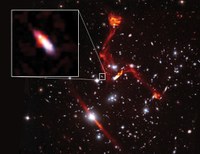 The Jansky Very Large Array has performed ultra-deep (1micro-Jy rms), high-resolution (< 0.6 arcsec) imaging of the Hubble Space Telescope cluster-lensed Frontier fields. These observations reveal hundreds of distant star-forming galaxies, from which the authors derive star formation rates and source sizes, unbiased by dust obscuration.
The Jansky Very Large Array has performed ultra-deep (1micro-Jy rms), high-resolution (< 0.6 arcsec) imaging of the Hubble Space Telescope cluster-lensed Frontier fields. These observations reveal hundreds of distant star-forming galaxies, from which the authors derive star formation rates and source sizes, unbiased by dust obscuration.
The faintest reliably identified radio source corresponds to a galaxy at z ~ 1, with a star formation rate of only 10 M⊙/yr, making it the faintest high-redshift star-forming galaxy detected to date in the radio continuum.
The observations of strongly-lensed fields provide important information for planning future deep fields with the Square Kilometre Array and the next generation Very Large Array.
Image Caption: Composite Very Large Array (3 GHz) and Hubble Space Telescope image, of the Frontier field MACSJ0717.5+3745 at 0.6 arcsec resolution. The large diffuse structures are radio relics and jets in the lensing cluster. The faintest source (inset) corresponds to a de-magnified flux density of 0.9 micro-Jy and is a star-forming galaxy at z ~ 1.
Publication 1: Ian Heywood (Oxford University, Rhodes University, South African Radio Astronomy Observatory) et al., The VLA Frontier Fields Survey: Deep, High-resolution Radio Imaging of the MACS Lensing Clusters at 3 and 6 GHz, Astrophysical Journal, 910, 105 (April 2021).
Publication 2: E.F. Jiménez-Andrade (NRAO) et al. The VLA Frontier Field Survey: A Comparison of the Radio and UV/Optical Size of 0.3 ≲ z ≲ 3 Star-forming Galaxies, Astrophysical Journal, 910, 106 (April 2021).
NRAO Press Release: IMAGE RELEASE: Cosmic Lens Reveals Faint Radio Galaxy
Magnetic Fields in a Coronal Mass Ejection
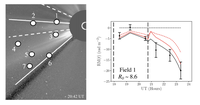 Coronal Mass Ejections (CMEs) are the most violent of space weather phenomena, traveling at ~ 1,000 km/sec, with potential for major impact on the Earth. Polarization observations with the Jansky Very Large Array, coupledwith real-time in situ density measurements by the Parker Solar Probe, have provided the most precise measurements of the magnetic field in a CME. Observations of the rotation measures toward background quasars through a CME yields a magnetic field strength of ~ 30 mG at 10 solar radii. The fields help to “sculpt” the CME as it travels away from the Sun.
Coronal Mass Ejections (CMEs) are the most violent of space weather phenomena, traveling at ~ 1,000 km/sec, with potential for major impact on the Earth. Polarization observations with the Jansky Very Large Array, coupledwith real-time in situ density measurements by the Parker Solar Probe, have provided the most precise measurements of the magnetic field in a CME. Observations of the rotation measures toward background quasars through a CME yields a magnetic field strength of ~ 30 mG at 10 solar radii. The fields help to “sculpt” the CME as it travels away from the Sun.
Image Caption: (Left) SOHO coronographic image of a CME, showing the location of background radio sources used for Faraday rotation measurements with the VLA. (Right) Time behavior of the rotation measures with passage of the CME in front of source 1.
Publication: Jason E. Kooi (U.S. Naval Research Laboratory) et al., VLA Measurements of Faraday Rotation Through a Coronal Mass Ejection Using Multiple Lines of Sight, Solar Physics, 296, 11 (January 2021).
The Dynamical Mass of a Protoplanetary Disk
 Elias 2-27 is a 0.8 Myr old M-star, with a massive protoplanetary disk. The disk has a 14 AU wide gap at 69 AU radius, suggesting a 0.1MJ forming planet. Atacama Large Millimeter / submillimeter Array (ALMA) imaging of the dust and CO 3-2 emission reveals spiral arms, and a rotating disk, providing the first dynamical mass estimate of a protoplanetary disk, with: Mstar = 0.46 M⊙ and Mdisk = 0.08 M⊙. Departures from Keplerian rotation suggest instabilities which may lead to planet formation.
Elias 2-27 is a 0.8 Myr old M-star, with a massive protoplanetary disk. The disk has a 14 AU wide gap at 69 AU radius, suggesting a 0.1MJ forming planet. Atacama Large Millimeter / submillimeter Array (ALMA) imaging of the dust and CO 3-2 emission reveals spiral arms, and a rotating disk, providing the first dynamical mass estimate of a protoplanetary disk, with: Mstar = 0.46 M⊙ and Mdisk = 0.08 M⊙. Departures from Keplerian rotation suggest instabilities which may lead to planet formation.
Image Caption: ALMA imaging of the protoplanetary disk of Elias 2-27. [Left] 3.3mm dust emission. [Center &and Right] 13CO 3-2 total intensity and the velocity field
Publication-1: Benedetta Veronesi (Universita degli Studi di Milano) et al., A Dynamical Measurement of the Disk Mass in Elias 2-27, Astrophysical Journal Letters, 914, L27 (June 2021).
Publication-2: Teresa Paneque-Carreño (Universidad de Chile) et al., Spiral Arms and a Massive Dust Disk with Non-Keplerian Kinematics: Possible Evidence for Gravitational Instability in the Disk of Elias 2-27, Astrophysical Journal, 914, 88 (June 2021).
NRAO Press Release: Study of Young Chaotic Star System Reveals Planet Formation Secrets
Jet Origin in a Massive Protostar
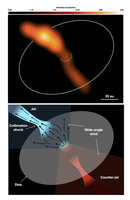 Protostellar jets have a fundamental role at the earliest evolution of protostars of all masses. In the case of low-mass (< 8M⊙) protostars, strong observational evidence exists that the launching and collimation is due to the X- and/or disk-wind mechanisms. In these models, it is the protostar/disk system that creates all the necessary conditions to launch and collimate the jets near the protostar via strong magnetic fields. The origin of jets from more massive protostars has been investigated much less, in part because of the difficulty of resolving the collimation zone in these more distant objects. Here, the authors present the highest angular resolution observations of a jet powered by a massive protostar, the Cep A HW2 radio jet. The radio emission was imaged at projected distances of only ~20 AU from the protostar, resolving the innermost 100 AU of a massive protostellar jet for the first time. The morphology of the radio jet emission in this massive object is very different than what is usually observed in jets from low-mass protostars. The authors found that the outflowing material in HW2 has two components: a wide-angle wind launched from the protostar/disk system, and a highly collimated jet starting at 20-30 AU from the protostar. Two possible scenarios are discussed: an extension of the classical disk-wind to a massive protostar, or external collimation of a wide-angle wind. These results have important consequences for understanding how stars of different masses are formed.
Protostellar jets have a fundamental role at the earliest evolution of protostars of all masses. In the case of low-mass (< 8M⊙) protostars, strong observational evidence exists that the launching and collimation is due to the X- and/or disk-wind mechanisms. In these models, it is the protostar/disk system that creates all the necessary conditions to launch and collimate the jets near the protostar via strong magnetic fields. The origin of jets from more massive protostars has been investigated much less, in part because of the difficulty of resolving the collimation zone in these more distant objects. Here, the authors present the highest angular resolution observations of a jet powered by a massive protostar, the Cep A HW2 radio jet. The radio emission was imaged at projected distances of only ~20 AU from the protostar, resolving the innermost 100 AU of a massive protostellar jet for the first time. The morphology of the radio jet emission in this massive object is very different than what is usually observed in jets from low-mass protostars. The authors found that the outflowing material in HW2 has two components: a wide-angle wind launched from the protostar/disk system, and a highly collimated jet starting at 20-30 AU from the protostar. Two possible scenarios are discussed: an extension of the classical disk-wind to a massive protostar, or external collimation of a wide-angle wind. These results have important consequences for understanding how stars of different masses are formed.
Image Caption: (Above) VLA 40 GHz image of the jets in the massive protostar, Cep A HW2, at 40 milli-arcsec resolution. (Below) The model for the conical wind and the narrow jet.
Publication: Carlos Carrasco-Gonzales ( Instituto de Radioastronoḿıa y Astrofısica, IRyA-UNAM) et al., Zooming into the Collimation Zone in a Massive Protostellar Jet, Astrophysical Journal Letters, 914, L1 (June 2021).
NRAO Press Release: Jets from Massive Protostars Might be Very Different from Lower-Mass Systems, Astronomers Find
Galactic Plane Survey First Results
 Surveys of the Milky Way at various wavelengths have changed our view of star formation in our Galaxy considerably in recent years. In this paper, the authors give an overview of the Global View on Star formation in the Milky Way (GLOSTAR) survey, a new survey covering large parts (145 square degrees) of the northern Galactic plane using the Jansky Very Large Array (VLA) in the frequency range 4−8 GHz, and the Effelsberg 100-m telescope. This provides for the first time a radio survey covering all angular scales down to 1.5 arcsecond, similar to complementary near- and mid-infrared galactic plane surveys. The authors outline the main survey goals and provide a detailed description of the observations and the data reduction strategy.
Surveys of the Milky Way at various wavelengths have changed our view of star formation in our Galaxy considerably in recent years. In this paper, the authors give an overview of the Global View on Star formation in the Milky Way (GLOSTAR) survey, a new survey covering large parts (145 square degrees) of the northern Galactic plane using the Jansky Very Large Array (VLA) in the frequency range 4−8 GHz, and the Effelsberg 100-m telescope. This provides for the first time a radio survey covering all angular scales down to 1.5 arcsecond, similar to complementary near- and mid-infrared galactic plane surveys. The authors outline the main survey goals and provide a detailed description of the observations and the data reduction strategy.
In these observations, the radio continuum is covered in full polarization, as well as the 6.7 GHz methanol maser line, the 4.8 GHz formaldehyde line, and seven radio recombination lines. The observations were conducted in the most compact D configuration of the VLA and in the more extended B configuration. This yielded spatial resolutions of 18 arcsec and 1.5 arcsec for the two configurations, respectively. The authors also combined the D configuration images with the Effelsberg 100-m data to provide zero spacing information, and jointly imaged the D- and B-configuration data for optimal sensitivity of the intermediate spatial ranges.
The authors show selected results for the first part of the survey, covering the range of 28° < l < 36° and |b|< 1°, including the full low-resolution continuum image, examples of high-resolution images of selected sources, and the first results from the spectral line data.
Image Caption: GLOSTAR 10 GHz image of the Galactic Plane
Publication: Andreas Brunthaler (Max-Planck-Institut für Radioastronomie) et al., A global view on star formation: The GLOSTAR Galactic plane survey. I. Overview and first results for the Galactic longitude range 28° < l < 36°, Astronomy & Astrophysics, 651, A85 (July 2021)
NRAO Press Release: New Study Reveals Previously Unseen Star Formation
Maintaining Future Star Formation
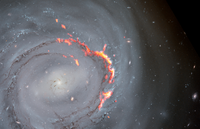 The authors investigate the effects of ram pressure on the molecular Interstellar Medium (ISM) in the disk of the Coma cluster galaxy NGC 4921, via high resolution CO observations. They present 6 arcsec resolution CO(1-0) observations of the full disk from the Combined Array for Research in Millimeter-wave Astronomy (CARMA), and 0.4 arcsec resolution Atacama Large Millimeter/submillimeter Array CO(2-1) observations of the leading quadrant, where ram pressure is strongest. They find evidence for compression of the dense ISM on the leading side, spatially correlated with intense star formation activity in this zone. They also detect molecular gas along kiloparsec-scale filaments of dust extending into the otherwise gas stripped zone of the galaxy, seen in Hubble Space Telescope images. The authors find the filaments are connected kinematically as well as spatially to the main gas ridge located downstream, consistent with cloud decoupling inhibited by magnetic binding, and inconsistent with a simulated filament formed via simple ablation. Furthermore, we find several clouds of molecular gas ∼1-3 kpc beyond the main ring of CO that have velocities which are blueshifted by up to 50 km/s with respect to the rotation curve of the galaxy. These are some of the only clouds detected here that do not have any visible dust extinction associated with them, suggesting that they are located behind the galaxy disk midplane and are falling back towards the galaxy. Simulations have long predicted that some gas removed from the galaxy disk will fall back during ram pressure stripping. This may be the first clear observational evidence of gas re-accretion in a ram pressure stripped galaxy.
The authors investigate the effects of ram pressure on the molecular Interstellar Medium (ISM) in the disk of the Coma cluster galaxy NGC 4921, via high resolution CO observations. They present 6 arcsec resolution CO(1-0) observations of the full disk from the Combined Array for Research in Millimeter-wave Astronomy (CARMA), and 0.4 arcsec resolution Atacama Large Millimeter/submillimeter Array CO(2-1) observations of the leading quadrant, where ram pressure is strongest. They find evidence for compression of the dense ISM on the leading side, spatially correlated with intense star formation activity in this zone. They also detect molecular gas along kiloparsec-scale filaments of dust extending into the otherwise gas stripped zone of the galaxy, seen in Hubble Space Telescope images. The authors find the filaments are connected kinematically as well as spatially to the main gas ridge located downstream, consistent with cloud decoupling inhibited by magnetic binding, and inconsistent with a simulated filament formed via simple ablation. Furthermore, we find several clouds of molecular gas ∼1-3 kpc beyond the main ring of CO that have velocities which are blueshifted by up to 50 km/s with respect to the rotation curve of the galaxy. These are some of the only clouds detected here that do not have any visible dust extinction associated with them, suggesting that they are located behind the galaxy disk midplane and are falling back towards the galaxy. Simulations have long predicted that some gas removed from the galaxy disk will fall back during ram pressure stripping. This may be the first clear observational evidence of gas re-accretion in a ram pressure stripped galaxy.
Image Caption: Composite ALMA CO 2-1 and Hubble Space Telescope image of the Virgo cluster spiral galaxy, NGC 4921.
Publication: William J. Cramer (Arizona State University) et al., Molecular Gas Filaments and Fallback in the Ram Pressure Stripped Coma Spiral NGC 4921, Astrophysical Journal (accepted for ApJ [publication on 24 July 2021).
NRAO Press Release: Scientists Observe Gas Re-accretion in Dying Galaxies for the First Time
ALMA and the First Galaxies
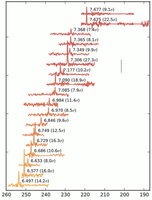 The Reionization Era Bright Emission Line Survey (REBELS) is a Cycle 7 Atacama Large Millimeter/submillimeter Array (ALMA) Large Program (LP) that is identifying and performing a first characterization of many of the most luminous star-forming galaxies known in the z>6.5 universe. REBELS is providing this probe by systematically scanning 40 of the brightest UV-selected galaxies identified over a seven square degree area for bright 158-micron [CII] and 88-micron [OIII] lines and dust-continuum emission. Selection of the 40 REBELS targets was done by combining photometric selections, each of which is subject to extensive vetting using three completely independent sets of photometry and template-fitting codes. Building on the observational strategy deployed in two pilot programs, the authors are increasing the number of massive interstellar medium (ISM) reservoirs known at z > 6.5 by ~4-5x to > 30. The authors motivate the observational strategy deployed in the REBELS program and present initial results. Based on the 60.6 hours of ALMA observations taken in the first year of the program (November 2019 to January 2020), 18 highly significant ≳ 7σ [CII] lines have already been discovered, the bulk of which (13/18) also show ≳ 3.3σ dust-continuum emission. These newly discovered lines more than triple the number of bright ISM-cooling lines known in the z > 6.5 universe, such that the number of ALMA-derived redshifts at z > 6.5 already rival Lyα redshift discoveries. An analysis of the completeness of our search results vs. star formation rate (SFR) suggests an ~79% efficiency in scanning for [CII] when the SFR(UV+IR) is in excess of 28 M⊙/yr. These new LP results further demonstrate ALMA's efficiency as a "redshift machine", particularly in the Epoch of Reionization.
The Reionization Era Bright Emission Line Survey (REBELS) is a Cycle 7 Atacama Large Millimeter/submillimeter Array (ALMA) Large Program (LP) that is identifying and performing a first characterization of many of the most luminous star-forming galaxies known in the z>6.5 universe. REBELS is providing this probe by systematically scanning 40 of the brightest UV-selected galaxies identified over a seven square degree area for bright 158-micron [CII] and 88-micron [OIII] lines and dust-continuum emission. Selection of the 40 REBELS targets was done by combining photometric selections, each of which is subject to extensive vetting using three completely independent sets of photometry and template-fitting codes. Building on the observational strategy deployed in two pilot programs, the authors are increasing the number of massive interstellar medium (ISM) reservoirs known at z > 6.5 by ~4-5x to > 30. The authors motivate the observational strategy deployed in the REBELS program and present initial results. Based on the 60.6 hours of ALMA observations taken in the first year of the program (November 2019 to January 2020), 18 highly significant ≳ 7σ [CII] lines have already been discovered, the bulk of which (13/18) also show ≳ 3.3σ dust-continuum emission. These newly discovered lines more than triple the number of bright ISM-cooling lines known in the z > 6.5 universe, such that the number of ALMA-derived redshifts at z > 6.5 already rival Lyα redshift discoveries. An analysis of the completeness of our search results vs. star formation rate (SFR) suggests an ~79% efficiency in scanning for [CII] when the SFR(UV+IR) is in excess of 28 M⊙/yr. These new LP results further demonstrate ALMA's efficiency as a "redshift machine", particularly in the Epoch of Reionization.
Image Caption: ALMA spectra of [CII] 158 micron emission from the REBELS sample at z = 6.5 to 7.7.
Publication: Rychard J. Bouwens (Leiden University) et al., Reionization Era Bright Emission Line Survey: Selection and Characterization of Luminous Interstellar Medium Reservoirs in the z>6.5 Universe, Astrophysical Journal (accepted), arXiv:2106:13719.
Water in the Early Universe
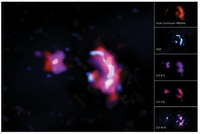 SPT0311-58 is the most massive infrared luminous system discovered so far during the Epoch of Reionization (EoR). In this paper, the authors present a detailed analysis of the molecular interstellar medium at z = 6.9, through high resolution observations of the CO(6 − 5), CO(7 − 6), CO(10 − 9), [CI](2 − 1), and p-H2O(21,1 − 20,2) lines and dust continuum emission with the Atacama Large Millimeter/submillimeter Array (ALMA). The system consists of a pair of intensely star-forming gravitationally lensed galaxies (labelled West and East). The intrinsic far-infrared luminosity is (16 ± 4)×1012 L⊙ in West and (27 ± 4)×1011 L⊙ in East. The authors model the dust, CO, and [CI] using non-local thermodynamic equilibrium radiative transfer models and estimate the intrinsic gas mass to be (5.4 ± 3.4)×1011 M⊙ in West and (3.1 ± 2.7)×1010 M⊙ in East. They find that the CO spectral line energy distribution in West and East are typical of high-redshift sub-millimeter galaxies (SMGs). The CO-to-H2 conversion factor (αCO) and the gas depletion time scales estimated from the model are consistent with the high-redshift SMGs in the literature within the uncertainties. They find no evidence of evolution of depletion time with redshift in SMGs at z > 3. This is the most detailed study of molecular gas content of a galaxy in the EoR to-date, with the most distant detection of H2O in a galaxy without any evidence for active galactic nuclei in the literature.
SPT0311-58 is the most massive infrared luminous system discovered so far during the Epoch of Reionization (EoR). In this paper, the authors present a detailed analysis of the molecular interstellar medium at z = 6.9, through high resolution observations of the CO(6 − 5), CO(7 − 6), CO(10 − 9), [CI](2 − 1), and p-H2O(21,1 − 20,2) lines and dust continuum emission with the Atacama Large Millimeter/submillimeter Array (ALMA). The system consists of a pair of intensely star-forming gravitationally lensed galaxies (labelled West and East). The intrinsic far-infrared luminosity is (16 ± 4)×1012 L⊙ in West and (27 ± 4)×1011 L⊙ in East. The authors model the dust, CO, and [CI] using non-local thermodynamic equilibrium radiative transfer models and estimate the intrinsic gas mass to be (5.4 ± 3.4)×1011 M⊙ in West and (3.1 ± 2.7)×1010 M⊙ in East. They find that the CO spectral line energy distribution in West and East are typical of high-redshift sub-millimeter galaxies (SMGs). The CO-to-H2 conversion factor (αCO) and the gas depletion time scales estimated from the model are consistent with the high-redshift SMGs in the literature within the uncertainties. They find no evidence of evolution of depletion time with redshift in SMGs at z > 3. This is the most detailed study of molecular gas content of a galaxy in the EoR to-date, with the most distant detection of H2O in a galaxy without any evidence for active galactic nuclei in the literature.
Image Caption: Composite showing the H2O, CO, and dust emission from a merging galaxy at z = 6.9.
Publication: Sreevani Jarugula (University of Illinois) et al., Molecular Line Observations in Two Dusty Star-Forming Galaxies at z = 6.9, Astrophysical Journal (accepted), arXiV:2108.11319.
NRAO Press Release: ALMA Scientists Detect Signs of Water in a Galaxy Far, Far Away
VLBA Images the First Extragalactic Neutrino Source
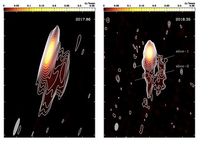 The Very Long Baseline Array (VLBA) demonstrated its unique ability to obtain the highest resolution images of parsec-scale relativistic jets with the discovery of a jet in the first known extragalactic neutrino source, the Blazar radio source TXS 0506+056.
The Very Long Baseline Array (VLBA) demonstrated its unique ability to obtain the highest resolution images of parsec-scale relativistic jets with the discovery of a jet in the first known extragalactic neutrino source, the Blazar radio source TXS 0506+056.
High energy neutrinos were detected by IceCube from TXS 0506+056. VLBA images with ~ 0.5 milli-arcsec resolution at 43 GHz detect complex jet structure and dynamics. Jet deceleration on scales ~ 100 parsec is seen – likely due to proton loading by jet-star interactions in the inner galaxy.
Image Caption: Nov 2017 and May 2018: Very Long Baseline Array 43 GHz images of the blazar TXS 0506+056 at ~ 0.5 milli-arcsec resolution, showing complex jet structure and dynamics in this first extragalactic neutrino source.
Publication: Eduardo Ros (Max-Planck-Institut für Radioastronomie) et al., Apparent superluminal core expansion and limb brightening in the candidate neutrino blazar TXS 0506+056, Astronomy & Astrophysics, 633, L1 (January 2020).
A New Type of Radio Transient
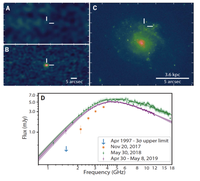 Comparison of images from the Very Large Array Sky Survey with older data from the Faint Images of the Radio Sky at Twenty-cm (FIRST) survey has revealed a new type of transient radio source, consistent with a merger-driven core collapse supernova. The source is associated with a soft gamma-ray burst detected in 2014 with the Monitor of All-sky X-ray Image (MAXI) instrument on the International Space Station.
Comparison of images from the Very Large Array Sky Survey with older data from the Faint Images of the Radio Sky at Twenty-cm (FIRST) survey has revealed a new type of transient radio source, consistent with a merger-driven core collapse supernova. The source is associated with a soft gamma-ray burst detected in 2014 with the Monitor of All-sky X-ray Image (MAXI) instrument on the International Space Station.
The new radio source is likely the result of a supernova driven by the collision between the neutron star or black hole companion of an evolved massive star. Such an event has been long theorized, but never before seen.
Image Caption: VT 1210+4956 was not detected in FIRST in1997 (A), but appears in the first epoch of the VLASS in 2017 (B). C shows the optical location in a dwarf galaxy at z = 0.035, and D shows the radio spectrum fit with a synchrotron self-absorption model.
Publication: D. Z. Dong (California Institute of Technology) et al., A transient radio source consistent with a merger-triggered core collapse supernova, Science, 373, 1125 (1 September 2021).
NRAO Press Release: Stellar Collision Triggers Supernova Explosion
How Galaxies Lose Their Gas
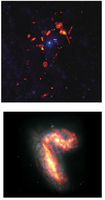 Toby Brown et al. present the Virgo Environment Traced in CO (VERTICO) survey, a new effort to map 12CO(2− 1), 13CO(2−1), and C18O(2−1) in 51 Virgo Cluster galaxies with the Atacama Compact Array, part of the Atacama Large Millimeter/submillimeter Array (ALMA). The primary motivation of VERTICO is to understand the physical mechanisms that perturb molecular gas disks, and therefore star formation and galaxy evolution, in dense environments. This first paper contains an overview of VERTICO’s design and sample selection, 12CO(2−1) observations, and data reduction procedures. The authors characterize global 12CO(2 − 1) fluxes and molecular gas masses for the 49 detected VERTICO galaxies, provide upper limits for the two non-detections, and produce resolved 12CO(2 − 1) data products (median resolution = 8 arcsec ≈ 640 pc). Azimuthally averaged 12CO(2 − 1) radial intensity profiles are presented along with derived molecular gas radii. The authors demonstrate the scientific power of VERTICO by comparing the molecular gas size–mass scaling relation for their galaxies with a control sample of field galaxies, highlighting the strong effect that radius definition has on this correlation. They discuss the drivers of the form and scatter in the size–mass relation and highlight areas for future work. VERTICO is an ideal resource for studying the fate of molecular gas in cluster galaxies and the physics of environment- driven processes that perturb the star formation cycle. Upon public release, the survey will provide a homogeneous legacy dataset for studying galaxy evolution in our closest cluster.
Toby Brown et al. present the Virgo Environment Traced in CO (VERTICO) survey, a new effort to map 12CO(2− 1), 13CO(2−1), and C18O(2−1) in 51 Virgo Cluster galaxies with the Atacama Compact Array, part of the Atacama Large Millimeter/submillimeter Array (ALMA). The primary motivation of VERTICO is to understand the physical mechanisms that perturb molecular gas disks, and therefore star formation and galaxy evolution, in dense environments. This first paper contains an overview of VERTICO’s design and sample selection, 12CO(2−1) observations, and data reduction procedures. The authors characterize global 12CO(2 − 1) fluxes and molecular gas masses for the 49 detected VERTICO galaxies, provide upper limits for the two non-detections, and produce resolved 12CO(2 − 1) data products (median resolution = 8 arcsec ≈ 640 pc). Azimuthally averaged 12CO(2 − 1) radial intensity profiles are presented along with derived molecular gas radii. The authors demonstrate the scientific power of VERTICO by comparing the molecular gas size–mass scaling relation for their galaxies with a control sample of field galaxies, highlighting the strong effect that radius definition has on this correlation. They discuss the drivers of the form and scatter in the size–mass relation and highlight areas for future work. VERTICO is an ideal resource for studying the fate of molecular gas in cluster galaxies and the physics of environment- driven processes that perturb the star formation cycle. Upon public release, the survey will provide a homogeneous legacy dataset for studying galaxy evolution in our closest cluster.
Image Caption: Upper: CO 2-1 emission from galaxies in the Virgo cluster, plus the optical image. Lower: Molecular gas in the merging galaxy system NGC 4567 and 4568.
Publication: Toby Brown ( Herzberg Astronomy and Astrophysics Research Centre, McMaster University) et al., VERTICO: The Virgo Environment Traced In CO Survey, 2021 Astrophysical Journal Supplement Series (accepted), arXiv:2111:00937.
NRAO Press Release: A Cosmic Whodunit: ALMA Study Confirms What’s Robbing Galaxies of Their Star-Forming Gas
GBT and VLBA Team Up to Image the Moon
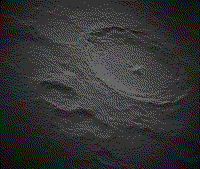 The Green Bank Observatory, National Radio Astronomy Observatory, and Raytheon Intelligence & Space released a new high-resolution image of the Moon in September 2021, the highest-resolution ever taken from the ground, using new radar technology on the Green Bank Telescope (GBT).
The Green Bank Observatory, National Radio Astronomy Observatory, and Raytheon Intelligence & Space released a new high-resolution image of the Moon in September 2021, the highest-resolution ever taken from the ground, using new radar technology on the Green Bank Telescope (GBT).
The resolution of the new Tycho Crater image is close to five meters by five meters and contains ~ 1.4 billion pixels. The image covers an area of 200 kilometers by 175 kilometers, ensuring that involved scientists and engineers captured the entire crater, which measures 86 kilometers in diameter.
For these images, the GBT was outfitted in late 2020 with new technology developed by Raytheon Intelligence & Space and Green Bank Observatory, allowing it to transmit a radar signal into space. Using the GBT and antennas from the Very Long Baseline Array (VLBA), several additional tests have been conducted since that time, focusing on the surface of the Moon, including the Tycho Crater and NASA Apollo landing sites.
Image Caption: This dramatic image of a 200 kilometer region with 5 meter resolution around the Tycho crater on the Moon was produced using the proto-type radar system at the GBO with VLBA antenna receiving stations.
NRAO Press Release: Astronomical Radar: Illuminating our Understanding of the Solar System


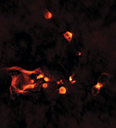



Connect with NRAO